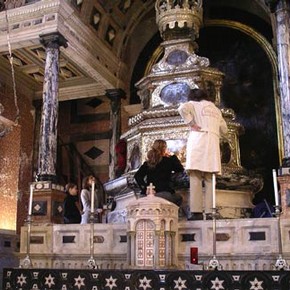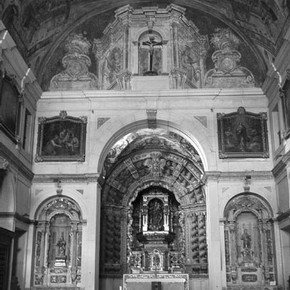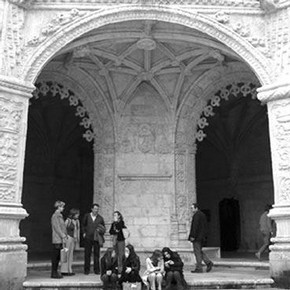Conservation Journal
Summer 2004 Issue 47
RCA/V&A Conservation study trip, March 2004: Lisbon, Portugal
The choice of Lisbon for the 2004 RCA/V&A Conservation study trip proved to be a good one. Along with some excellent food, wine, and shopping, we visited some truly fascinating conservation institutions, and were offered an illuminating insight into how conservation is practised in another European city. During the five days we visited museums, universities, and institutions that practice conservation in both the public and private arena. Attending this year's study trip were: Anna Kagiadaki (MA: Sculpture Conservation), Melissa Gunter (MA: Conservation of Natural History Collections), Timea Tallian (MPhil: Science and Secrets of Early Portrait Miniature Painting), William Lindsay (Head of Department, RCA/V&A Conservation), Alison Richmond (Deputy Head of Department and Senior Tutor, RCA/V&A Conservation), Vincent Daniels (Science Research Fellow), and Harriet Standeven (Tutor, RCA/V&A Conservation).
The itinerary for the trip was full, with a variety of institutions and people to visit. Our first visit took us to the Portuguese Institute of Conservation where we met the Director, Dr. Ana Isabel Seruya. The Institute works on a huge variety of artworks and artefacts and we were given a full and fascinating tour of their well-equipped laboratories, visiting the paintings, textiles, furniture and paper conservation sections. That afternoon we met Rui Xavier from the Conservation Department of the Gulbenkian Museum. Although the Gulbenkian Museum was closed to the public that day, we were given a wonderful private tour of the collections followed by a visit to the Conservation Department, where Xavier was working on some beautiful Japanese lacquered screens which were cracking and flaking.

Figure 1: Conservators working on the copper paintings in the silver alterpiece at the Irish Convent of Nuns (click image for larger version)
The next day was spent with the very hospitable Luis Figueira, a director of the private firm, Sociedade de Conservacao, Restauro e Arte, who spend a great deal of their time working on site. We were taken to four different churches that were currently undergoing conservation or had recently been finished, as well as being treated to a fantastic lunch. The first was The Irish Convent of Nuns, established in 1639, which contained a beautiful silver altarpiece that was undergoing conservation work (Figure 1). The altarpiece was inset with a number of oil on copper paintings. These had been damaged over the years by over-enthusiastic cleaning with the metal polish used on the surrounding silver. As well as treating the paintings, the conservators were in the process of devising a simple means of protecting the paintings in the future whilst the silver was cleaned. The second stop was Jeronimo Monastery in Belém, where four large paintings situated high up behind the altarpiece had been conserved. Here, we were also allowed to climb up onto the roof of the monastery, which afforded amazing views of the city.
The third place we visited was a beautiful late seventeenth century church, Santuário de Nossa Senhora do Cabo, situated on a cliff top overlooking the ocean. The conservation work on this site included the cleaning of the altarpiece, the paintings on the ceilings and walls, and the polychromed wood, whose decorative schemes had been overpainted (Figure 2). Being situated so close to the sea, the church had a real problem with sand and dust and the conservators expressed concern over the amount of debris that had accumulated in just two years.

Figure 2: The restored interior of the church, Santuário de Nossa Senhora do Cabo (click image for larger version)
The fourth church was situated in the centre of Lisbon. Conservators were just finishing cleaning the paintings on the ceiling, and were about to remove the extensive scaffolding that had been hiding the work. This was a particularly interesting project as the ceiling paintings had been so discoloured (almost black) that no one living could remember what they looked like. Figueira and his crew were obviously excited at the prospect of unveiling the paintings for the first time.
On the third day, half of the group returned to the Gulbenkian Museum to visit the Centre for Modern Art, where art historian Ana Vasconcelos gave a fascinating tour of the store rooms housing twentieth-century paintings and sculpture, primarily by British and Portuguese artists. Ana had a particular interest in the practical and ethical considerations of the care of contemporary art, and it is hoped that this contact offers an exciting opportunity for collaboration between the Centre for Modern Art and ourselves in the future. The other half of the group visited the Portuguese version of the Natural History Museum. Unfortunately, most of the museum is under construction and few exhibits were open to the public.

Figure 3. The group in the cloisters of the Jeronimo Monestery in Belém. (click image for larger version)
That afternoon we gave short presentations, introducing the RCA/V&A Programme, to a group of students from the Conservation Department of the Universidade Nova of Lisbon. Lecturer and chemist Maria João Seixas Melo took us on a tour of the University's facilities and some of their students gave presentations of their work. The University runs a five year course in conservation, which is based in the Chemistry Department. The final year students' projects were thus very much science-focused and included research into new techniques, such as the washing and de-acidification of paper using nano technology.
Our trip also included some free time to visit other sites in Lisbon. The Botanical Gardens near the Science Museum were quite beautiful, whilst the Castelo de São Jorge, which is situated on the top of a hill, offered exceptional views of the city. Other highly recommended sites included the Archaeological Museum, the Tile Museum and the Aquarium, which is the second largest in the world and housed some amazing animals including a truly enormous manta ray.
Lisbon is a beautiful city full of culture and history. The food is fantastic, the churches are beautiful, and the people are so very welcoming. This experience not only gave the students many different perspectives on conservation, but also encouraged reflection and discussion about how the conservator fits into a culture. The study trip is an essential element in the RCA/V&A Conservation Programme and proved to be very successful this year.
Summer 2004 Issue 47
- Editorial
- Conservation Department away day - December 2003
- Future challenges for RCA/V&A conservation
- RCA/V&A Conservation - do professional conservators make a contribution?
- Traditional Japanese lacquer workshop: Summer 2003
- The Internship and Placement Programme at the V&A Conservation Department
- LightCheck®: A new tool in preventive conservation
- RCA/V&A Conservation study trip, March 2004: Lisbon, Portugal
- Printer friendly version